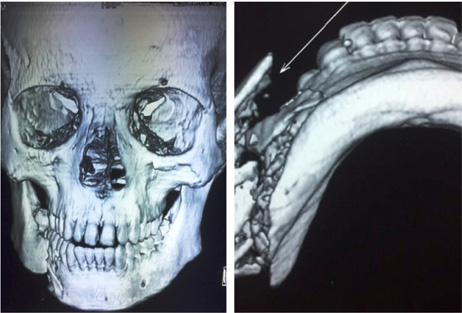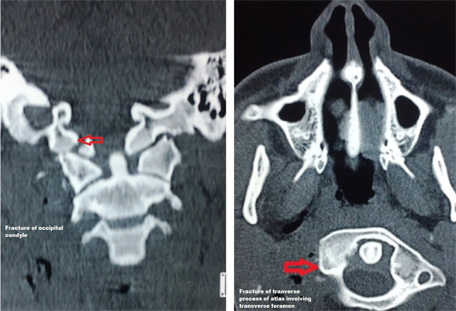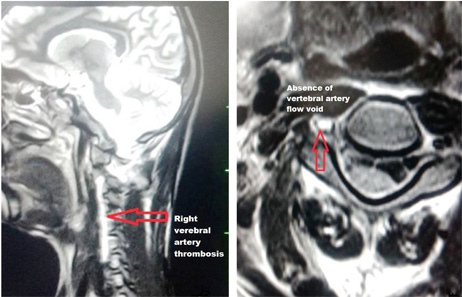J Dent Anesth Pain Med.
2018 Jun;18(3):183-187. 10.17245/jdapm.2018.18.3.183.
Airway management in a displaced comminuted fracture of the mandible and atlas with a vertebral artery injury: A case report
- Affiliations
-
- 1Anaesthesiology, Saveetha University, Chennai, India. drrathna86@yahoo.co.in
- KMID: 2415183
- DOI: http://doi.org/10.17245/jdapm.2018.18.3.183
Abstract
- Complex cervical spine fractures are a serious complications of maxillofacial trauma and associated with high mortality and neurological morbidity. Strict vigilance in preventing further insult to the cervical spine is a crucial step in managing patients who are at risk for neurologic compromise. We report a rare case of a right transverse process of atlas fracture with right-sided vertebral artery injury that was associated with a comminuted fracture of the body and angle of the mandible, which restricted mouth opening. Airway management was performed by an awake fiber-optic nasotracheal intubation, where neck movement was avoided with a cervical collar. Vertebral artery injuries may have disastrous consequences, such as basilar territory infarction and death, and should be suspected in patients with head and neck trauma. After mandibular plating, the patient was on cervical collar immobilization for 12 weeks and anti-coagulant therapy.
MeSH Terms
Figure
Reference
-
1. Fassett DR, Dailey AT, Vaccaro AR. Vertebral artery injuries associated with cervical spine injuries: a review of the literature. J Spinal Disord Tech. 2008; 21:252–258.
Article2. Lalani Z, Bonanthaya KM. Cervical spine injury in maxillofacial trauma. Br J Oral Maxillofac Surg. 1997; 35:243–245.
Article3. Mukherjee S, Abhinav K, Revington PJ. A review of cervical spine injury associated with maxillofacial trauma at a UK tertiary referral centre. Ann R Coll Surg Engl. 2015; 97:66–72.
Article4. Mulligan RP, Friedman JA, Mahabir RC. A nationwide review of the associations among cervical spine injuries, head injuries, and facial fractures. J Trauma. 2010; 68:587–592.
Article5. Carpenter S. Injury of neck as cause of vertebral artery thrombosis. J Neurosurg. 1961; 18:849–853.
Article6. Park HK, Jho HD. The management of vertebral artery injury in anterior cervical spine operation: a systematic review of published cases. Eur Spine J. 2012; 21:2475–2485.
Article7. Cothren CC, Moore EE, Biffl WL, Ciesla DJ, Ray CE Jr, Johnson JL, et al. Anticoagulation is the gold standard therapy for blunt carotid injuries to reduce stroke rate. Arch Surg. 2004; 139:540–545. discussion 545-6.
Article8. Torina PJ, Flanders AE, Carrino JA, Burns AS, Friedman DP, Harrop JS, et al. Incidence of vertebral artery thrombosis in cervical spine trauma:correlation with severity of spinal cord injury. Am J Neuroradiol. 2005; 26:2645–2651.9. Lee MA, Choi KK, Lee GJ, Yu BC, Ma DS, Jeon YB, et al. A Blunt Traumatic Vertebral Artery Injury: A Case Report. J Trauma Inj. 2016; 29:28–32.
Article10. Biffl WL, Moore EE, Elliott JP, Ray C, Offner PJ, Franciose RJ, et al. The devastating potential of blunt vertebral arterial injuries. Ann Surg. 2000; 231:672–681.
Article11. Veras LM, Pedraza-Gutierrez S, Castellanos J, Capellades J, Casamitjana J, Rovira-Canellas A. Vertebral artery occlusion after acute cervical spine trauma. Spine. 2000; 25:1171–1177.
Article12. Cogbill TH, Moore EE, Meissner M, Fischer RP, Hoyt DB, Morris JA, et al. The spectrum of blunt injury to the carotid artery: a multicenter perspective. J Trauma. 1994; 37:473–479.13. Cothren CC, Moore EE, Ray CE Jr, Johnson JL, Moore JB, Burch JM. Cervical spine fracture patterns mandating screening to rule out blunt cerebrovascular injury. Surgery. 2007; 141:76–82.
Article14. Sawlani V, Behari S, Salunke P, Jain VK, Phadke RV. “Stretched loop sign” of the vertebral artery: a predictor of vertebrobasilar insufficiency in atlantoaxial dislocation. Surg Neurol. 2006; 66:298–304.
Article15. Desouza RM, Crocker MJ, Haliasos N, Rennie A, Saxena A. Blunt traumatic vertebral artery injury: a clinical review. Eur Spine J. 2011; 20:1405–1416.
Article
- Full Text Links
- Actions
-
Cited
- CITED
-
- Close
- Share
- Similar articles
-
- Endovascular Management of Iatrogenic Vertebral Artery Pseudoaneurysm: A Case Report
- Atlantal Fracture and Dislocation with Transverse Ligament Rupture Associated with Quadriplegia
- Vertebral Artery Injury Following Blunt Trauma to the Cervical Spine Case Report and Literature Review
- Vertebral Artery Injury during Anterior Cervical Spine Surgery: Report of Two Cases
- Injury of the Ascending Branch of the Lateral Femoral Circumflex Artery Caused by a Spike of the Displaced Lesser Trochanter in an Intertrochanteric Femoral Fracture - A Case Report -





